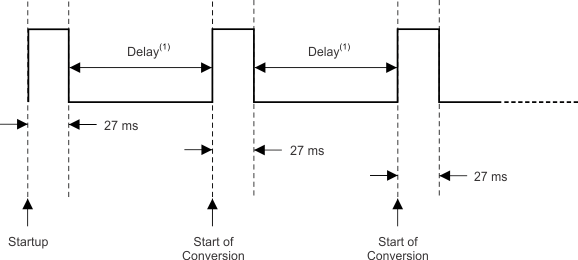SBOS721A October 2014 – June 2022 TMP75B-Q1
PRODUCTION DATA
- 1 Features
- 2 Applications
- 3 Description
- 4 Revision History
- 5 Pin Configuration and Functions
- 6 Specifications
-
7 Detailed Description
- 7.1 Overview
- 7.2 Functional Block Diagram
- 7.3
Feature Description
- 7.3.1 Digital Temperature Output
- 7.3.2 Temperature Limits and Alert
- 7.3.3 Serial Interface
- 7.4 Device Functional Modes
- 7.5 Programming
- 7.6 Register Map
- 8 Application and Implementation
- 9 Power-Supply Recommendations
- 10Layout
- 11Device and Documentation Support
- 12Mechanical, Packaging, and Orderable Information
Package Options
Mechanical Data (Package|Pins)
Thermal pad, mechanical data (Package|Pins)
Orderable Information
7.4.1 Continuous-Conversion Mode
The default mode of the TMP75B-Q1 is continuous conversion, where the ADC performs continuous temperature conversions and stores each result to the temperature register, overwriting the result from the previous conversion. Conversion rate bits CR1 and CR0 in the configuration register configure the TMP75B-Q1 for typical conversion rates of 37 Hz, 18 Hz, 9 Hz, or 4 Hz. The TMP75B-Q1 has a typical conversion time of 27 ms. To achieve different conversion rates, the TMP75B-Q1 makes a conversion, and then powers down and waits for the appropriate delay set by CR1 and CR0. The default rate is 37 Hz (no delay between conversions).Table 7-4 shows the settings for CR1 and CR0.
| CR1 | CR0 | CONVERSION RATE (TYP) | IQ (TYP) |
|---|---|---|---|
| 0 | 0 | 37 Hz (continuous conversion, default) | 45 μA |
| 0 | 1 | 18 Hz | 22 μA |
| 1 | 0 | 9 Hz | 12 μA |
| 1 | 1 | 4 Hz | 6.5 μA |
After power-up or a general-call reset, the TMP75B-Q1 immediately starts a conversion, as shown in Figure 7-6. The first result is available after 27 ms (typical). The active quiescent current during conversion is 45 μA (typical at 25°C). The quiescent current during delay is 1 μA (typical at 25°C).
